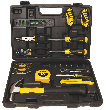Consider the surface area that you are working with when choosing a paintbrush. If you are painting trim or molding, you need a small brush than the type you need for a wall. Experts agree that you will only need three types of paintbrushes for completing home painting projects. For walls, use a four-inch wall brush. For sash and trim work, use a one-and-a-half-inch sash brush and a two-inch trim brush. Angled brushes are good for trims and moldings, while flat brushes are best for painting up to the edge of corners.
If your painting project involves a large room, or several rooms, remember that you will hold a paintbrush in your hand for a long period of time, and choose a handle with which you are comfortable. While you're perusing paintbrushes at the hardware store, hold the paintbrush in your hand and imagine yourself using it for a long time. A large handle on a four-inch brush will most likely be better than a skinny handle, such as on a trim brush.
Remember to clean your paintbrushes when your project is complete. If you maintain your brushes properly, they will last for years over many home painting projects.

Find the Right Tool Right Away Finally, a homeowner's set that includes all the tools needed to complete basic DIY projects at an affordable price! The tools are stored in a molded case for security and portability. Check out Stanley 65-Piece Homeowner's Tool Kit today!
Just as with any task, when painting a room you will need to make sure that you have the correct tools. Surprisingly ...
Discover MoreAre you looking for a way to change the look of a room that has wallpaper, but you don't really feel like pulling the ...
Discover MoreStains vs. sealers has long been a debate among those who work with wood. The truth of the matter is that both have their ...
Discover MoreThere are currently no comments for this tip. (Be the first to leave your comment—just use the simple form above!)
Copyright © 2025 Sharon Parq Associates, Inc.
Comments